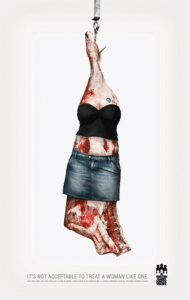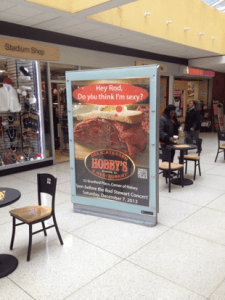Carol Adams work is another example of literature that illuminates the inequality and wrongdoings that are so apparent in our culture. Adams work focuses on the ideas we have let go largely unchecked when it comes to our relationships with animals and women. Adams sets the scene by first off examining genocide, one of the most abhorrent atrocities that mankind is capable of. To understand why we can so easily slaughter, she firsts asks why we allowed ourselves to do so to humans. We allow ourselves to be so lethal towards each other because we in fact do not consider the victim to be of the same status as ourselves, so we do not empathize with them. By doing this it is easier to accept the abuse because we don’t imagine what the pain associated must feel for the victim. We do not consider each victim as an individual, we just lump them together and address them as a singular entity. In the case of genocide, the victims are looked at as an infestation that must be eliminated, and are reduced to a being that is below humans in the hierarchy. The derogatory words used to describe the victims being are important, and help illicit hate and disgust without any real justification, instead being based solely of association.
Adams references Jacques Derrida, author of “The Animal that Therefore I am” who explains that we have a campaign against compassion that has allowed us to not blink an eye at the mass slaughter of animals. “Such a campaign instantiates objectification: both the objectification of the other animals who become mass terms, and the objectification of feelings so that they fail to be heeded in making decisions about the fate of terminal animals” (Adams 10). While the campaign on compassion not only diminishes those who we perceive to be lesser being, it as well negates any feelings of guilt and empathy towards the victims, allowing atrocious acts to both occur and then go unrivaled. This has let us become complacent, and stray further and further away from where a pure conscious should conclude that violence should not be inflicted on those who cannot defend themselves. “The war on compassion has caused many people to think it is futile to care” (Adams 10). Our political system is not set up in a way that allows for us to object to the status quo. People may have these thoughts, but they commonly fizzle out before they transform into anything that can truly enact change.
When discussing the portrayal of women and animals in society, it is important consider how our society views what’s around us. Adams references Rosemarie Garland-Thompson author of Staring: How we Look, who said “In late Captalism, the predominant form of looking, the mass exercise of ocularcentricity, is what we might call consumer vision.” “Animalizing women and feminizing animals helps in this process because it renders women and dead animals used as flesh as commodities” (Adams 15). By reducing woman and animals to lesser beings, they can be viewed as merely object for one’s own satisfaction, whether that be sexual or food-wise.
The first picture I chose to discuss is the one with a chicken head cropped onto an incredibly robust body. The placement of the chicken head alludes to the idea that meat makes someone physically strong. In the background, you can see what I assume to be dead chickens hanging on meat hooks, which certainly do not evoke images of health and strength.
This next picture shows a carcass of an animal on a meat hook that is dressed in women’s clothes, stating it’s not acceptable to treat a woman like an animal. The subtext goes on to encourage men to be vocal, as it assumed that most would agree with the message. This falls in line with the notion that dissenting views are often not welcomed, so we are conditioned to keep them mostly to ourselves. While the add addresses gender inequality, it does not mention anything about the violence towards animals who are degraded to be viewed as nothing more than a slab a meat.
The last picture from the catalog I wanted to examine is this restaurant add asking Rod Stewart if he thinks the sandwich is sexy, alluding to one of his songs, since he is performing after the restaurant opens. While advertisements are obviously meant to appeal to the viewer, we see here that it is not the restaurant asking if the sandwich is sexy, but instead the sandwich itself, so technically the animal that the meat is derived from. The idea that a cow would want to be deemed sexy is absurd, and coincided with the idea that many woman who are raped are in some way asking for it, based off their behavior or appearance. “They mix death with degradation. That equation has one answer: the dead animal equals the female position. Pornographic conventions bleed into the bloodied animals that are shown wanting to be consumed, that is, wanting their own death” (Adams). The idea is that any sort of apprehension towards the consumption is reduced by the animal consenting in the same way women are made to be submissive and consenting to man.
The image that I found for myself is one of an attractive woman devouring a burger on a beach. This image is supposed to evoke the raw urges of society to exploit naked women and fresh meat.
The connection between fetishizing woman and meat is strong, so I decided to see how they may be linked to each other biologically. I found an article on the link between meat consumption and sex drive, and apparently, there is a connection where low meat intake leads to low libido. “Individuals who don’t consume enough protein actually risk having a low testosterone level, according to recent research. And low levels of this important hormone can cause not just poor sexual function, but muscle loss, damage to bones, and reduced red blood cells” (Black). Testosterone is not the only factor, zinc also increases libido as well, the article attributes to Tanya Zuckerbro, MS, RD. However, the article does not say that it is the meat itself that leads to the higher libido, just the nutrients meat provides. “Protein is important, but you can also get it from other sources” (Black). As we covered in the vegetarian portion of the class, there are many substitutes to meat. It’s important to consider these substitutes as they would not cause for needless suffering of animals. Perhaps there is another link outside of the ecofeminism perspective, where society has been associating woman and sex with meat because the more meat a guy eats, the more they think about sex, and the more likely they are to have a high meat diet if they are consumed by the idea of sexualizing woman.
When it comes to art, Adams advocates for the rights of the animals affected by the art over the artistic freedom of the creator of the piece. She is trying to challenge the system in which we allow art to overstep individual boundaries because it is trying to illustrate something grand, all the while creating casualties. Adams argues that artistic expression isn’t a viable reason to infringe on the rights of those being exploited.
Whether in art, advertisements, or the interactions between different divisions, it’s clear that we have become desensitized to the marginalization and abuse casted towards woman, animals, and any group that is less privileged. In whatever scenario, when a hierarchy is introduced, it allows for the concerns of the those below you on the hierarchy to be disregarded. Women and animals can be looked at interchangeably, they both simply represent the oppressed. “Ultimately it wasn’t about taste. It was always about their sense of self, their sense of entitlement and privilege” (Adams 24). When we examine different forms of media presented to us, like ads urging us to eat meat, we realize that it’s not so much the claim to eat meat that is harmful, but the perpetuation of a hierarchy that allows for some to be placed above others.
When these hierarchies exist, they seep through to other aspects of our lives and how we interact with the world around us, and importantly it’s beings, and create a scenario in which the privileged want’s triumph the right of the victims.
https://encrypted-tbn0.gstatic.com/images?q=tbn%3AANd9GcRSFwnd6v4aSMQk6AzMS0DhMjYw1ZYUEB8-hxfm233xk2liSXzI
https://www.express.co.uk/life-style/health/874634/sex-libido-diet-testosterone-red-meat-zinc-best-supplements




